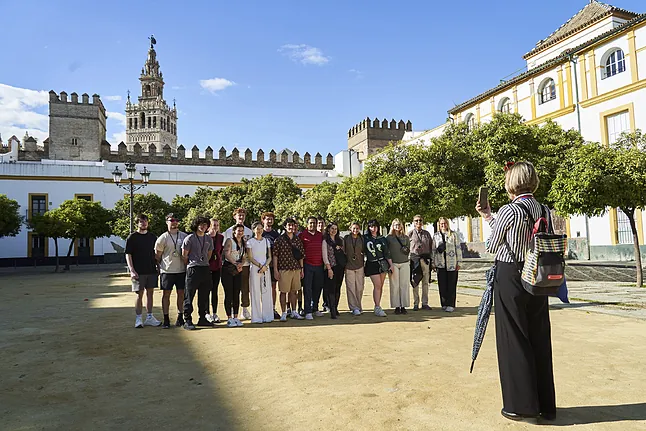After the series of storms that have hit half the country in recent weeks, cities are regaining life in their streets. And in a big way. In tourist capitals like Seville, the area around the Cathedral, the Giralda, and the Real Alcázar are filled with visitors from all nationalities. A legion of horse-drawn carriages stationed in the shade of the Archivo de Indias awaits them. There are young people chatting in Italian, a couple resting on a staircase speaking in English, while a group of French, Portuguese, Japanese... Another small Babel passes by.
Through the door of the Real Alcázar in the Patio de Banderas, a group of 17 students from the University of Akron, Ohio, from the United States, with two professors, exit. They are accompanied by the guide Viviana Coraini, president of the Provincial Association of Tourist Informants (APIT) of Seville, and Tereza de Wolf Micadova, from the company International Study Programs, which facilitated the trip. They leave marveling at the monument with over a thousand years of history where some scenes of the acclaimed series Game of Thrones were filmed. They are open-minded and eager to share their experience in amazing Seville. This American delegation is the opposite of the stern President Trump.
The 'Andalusian Crush' campaign ad projected on a screen in Times Square in New York.El Mundo
They study marketing and business. They are impressed by the street bustle, colors, and scents. Spring has brought out the orange blossom flowers and their aroma permeates everything. Everything is so different from what they usually see in the United States, comments the 20-year-old student Zoe Graham. These young people and their professors are part of the numbers of American travelers who visit Andalusia every year. Last year there were 753,555, more than double than in 2019, the year before the coronavirus pandemic that abruptly halted global tourism.
Travelers from the United States are now the focus of administrations and sector companies, which are directing their strategies to capture their attention. "They are the biggest spenders, educated, travel outside of the high season, and interact much more with the local population," summarizes the Tourism and External Andalusia Counselor of the Andalusian Government, Arturo Bernal. According to data from the Junta, international travelers spend around 170 euros per day, excluding flights, while Americans, on average, exceed 220 euros. As more than half of the tourists visiting Andalusia are domestic, the average spending of all of them is much lower, around 82 euros.
In many cities in the country where tourism phobia is growing and residents are rebelling against the massive influx of visitors, communities are opting for quality over quantity and redirecting their strategies to explore high standing niches. "For us, the US market is a priority because it can bring us that quality tourist who meets the expectations of the tourism ecosystem," says Bernal. Therefore, the old "Yankees, go home" shouted in demonstrations against American bases in Andalusia has shifted to "Yankees, welcome home" chanted by administrations to attract high purchasing power tourists.
But administrations also seek to cherish the local population. When tourists are asked about the destination, they value the gastronomy, heritage, climate, and the "friendly and empathetic character that is the Andalusian," boasts the counselor. Therefore, the value of Andalusians is key in the tourism "ecosystem." "It is the absolutely differential and qualitative element of our tourism offer. It carries as much weight or more than any of our best monuments," admits Bernal.
In this context, the struggle to increase the number of visitors every year and break records no longer makes much sense. "It has generated a kind of psychosis in the population. It is ridiculous and makes no sense," concludes the counselor, who advocates for "controlled" growth.
There is another element that makes the American tourist particularly attractive. They do not travel during the summer high season, the traditional sun and beach season in Andalusia. This traveler usually lands in the Andalusian community in the first quarter and the last four months of the year. This is what the group of American university students who visited the Real Alcázar did. The guide accompanying them confirms this. "Yes, in spring, there are usually groups of students and families. In contrast, in summer, it slows down a lot."
Statistics also confirm this. Of the nearly 800,000 tourists who visited the Andalusian community in 2024, May and October have the highest demand, with 91,367 and 90,551 travelers from the United States in each of those months. In August, the number dropped by almost half, with 47,486 Americans. This distribution throughout the year is key to "managing seasonality" in tourism in Andalusia, which had been "our great battle," explains Bernal.
The weight of the tourism sector in Andalusia is crucial. Last year, the 36.2 million travelers in the community generated an impact of 30 billion euros on the economy, 13% more than the previous year, with 400,000 jobs associated with the sector, 4% more than the previous year.
Faced with such figures, the Government of Juanma Moreno spared no expense in the Andalusian Crush promotional campaign, starring Game of Thrones actor Peter Dinklage, which could be seen at NBA basketball games and in the best locations in New York and Miami, among other cities worldwide. This campaign, which started in 2023, cost 38 million. Last year, the second phase was launched, with a budget of 6 million. A large part of that million-dollar bill - 85% - was paid with European funds. The impact of the first phase was colossal: almost 2.4 billion views. Half of them in the United States.
But no matter how dazzling the promotion is, what matters is what the tourist finds at their destination. And for Akron student Kristina Myers, who wants to be a dietitian, what has amazed her are the small shops in the center of Seville filled with fresh fruit, freshly baked bread, seafood... In tourism, every detail counts.
